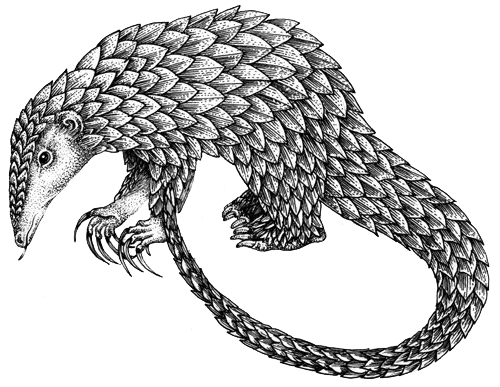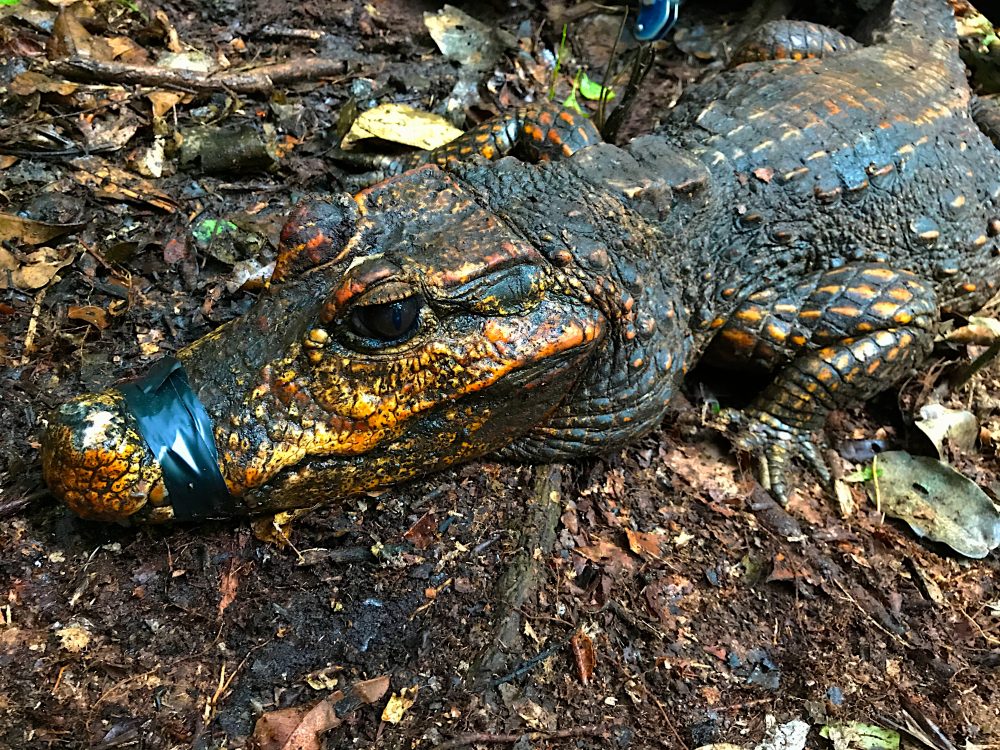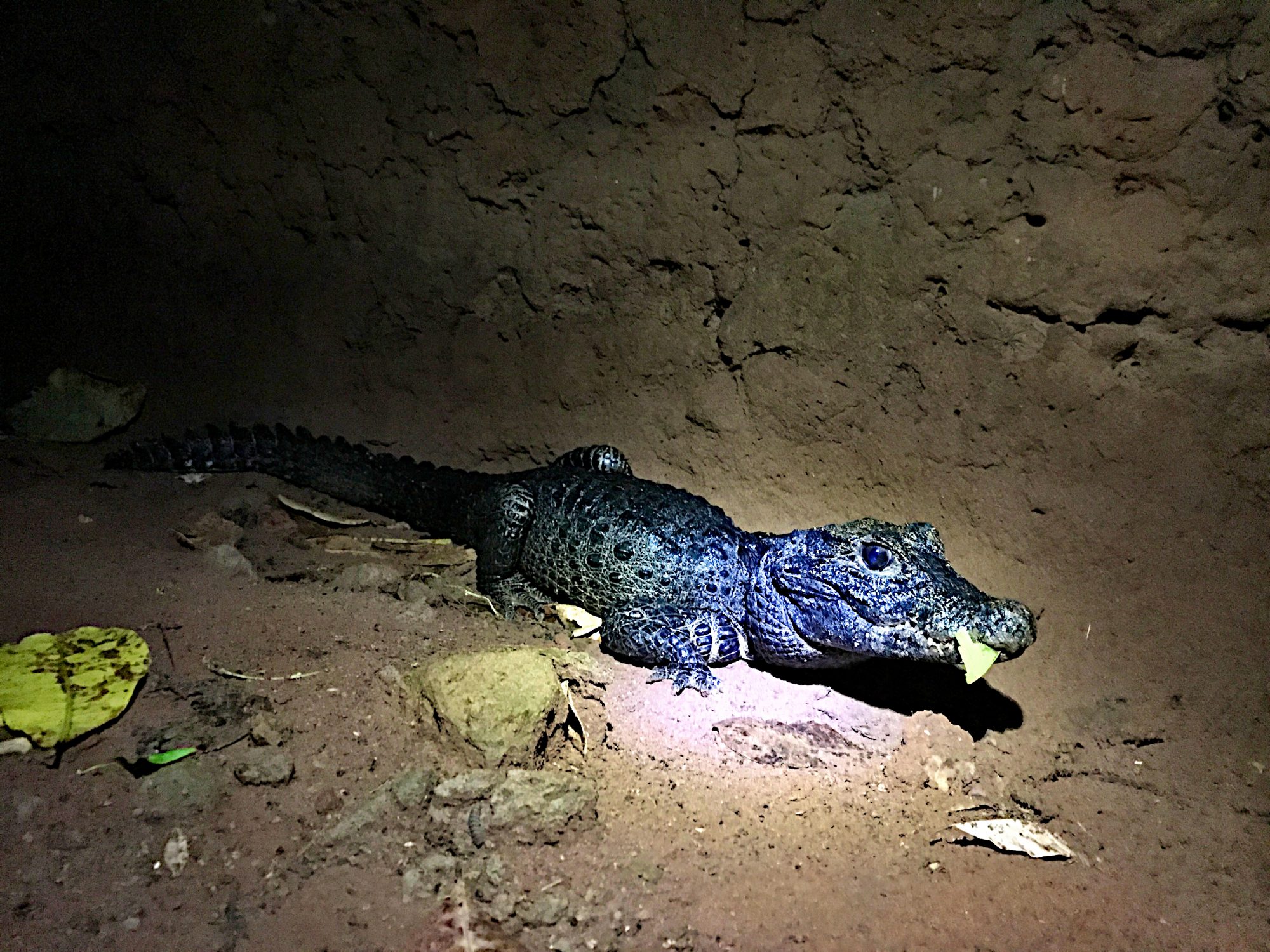Pangolin
Pangolin
It wasn’t until 2006 that the term Mecistops was resurrected and once again came into common use for these unique crocodilians.
Africa’s Slender-Snouted Crocodiles fall into the genus Mecistops
The genus Mecistops was originally described by Gray in 1844, though fell out of use by the end of the 19th century when the African slender-snouted crocodile was thought to be a “true” crocodile in the genus Crocodylus. It wasn’t until 2006 that Mecistops was resurrected and once again came into common use for these unique crocodilians.
A recent study assessing the genetic and morphological variation found across the distribution of Mecistops (i.e., Gambia to Lake Tanganyika) found that the significant genetic and cranial morphological divergence was highly geographically structured. Crocodiles from West Africa were found to be easily distinguished from crocodiles found in Central Africa and, in fact, it was estimated that crocodiles from these two regions had been isolated from each other for as long as 7 million years.

Etymology & Habitat
When Cüvier (1824) originally described this species he did not provide an etymological description of the chosen specific epithet (cataphractus). We assume it came from the Greek kataphraktos (κατάφρακτος) meaning armored, shielded or completely enclosed. Cüvier (1824) also gave this species the French common name “crocodile a nuque cuirassée,” which roughly means “armor-necked crocodile.” Both the Latin and French are presumably in reference to the extra rows of dorsal scutes compared to other crocodiles of the genus Crocodylus.
M. cataphractus is, or at least was historically, widely distributed throughout West Africa from the Niger River delta (Nigeria) west to the Gambia River (The Gambia). Published site-specific records for this species are somewhat abundant, largely owing to the work of Waitkuwait (1985). Interestingly, at least one historic account describes anecdotally how rare this species seemed to be as early as the mid 19th Century (Baikie 1857).
The West African slender-snouted crocodile can be found in medium to large-sized rivers and lakes throughout its distribution. Individuals of all sizes readily use many other aquatic habitats of appropriate size, including flooded forests, “small” forest stream networks, and papyrus and emergent grass swamps at sites where the river and lake margins flood into adjacent terrestrial habitats.


Feeding & Breeding
It might be easy to make the assumption that West African slender-snouted crocodiles are primarily piscivorous (fish eaters), but the reality is that these crocodiles are fairly generalist taking fish, aquatic birds, even larger prey opportunistically like duikers, aquatic chevrotain, genets, civets, monkeys, etc… Fortunately, there are no confirmed instances of this species attacking or predating people.
As part of his dissertation research, Ekke Waitkuwait wrote extensively on the reproductive ecology of West African slender-snouted crocodiles. We know that they are mound-nesting species that construct mound nests within 10 m of the high water mark. Often these nests can be at the base of a big tree. This species was also recorded nesting in a cacao plantation suggesting it is somewhat tolerant of forest replacement habitats.
Observations in Cote d’Ivoire show that this species nesting cycle is directly dependent on the rainy season and high water levels. Nests are constructed at the very end of the dry season and eggs are laid 5 – 47 days after the mound nest is constructed. Clutch sizes for M. cataphractus in the wild are quite small averaging 16 ± 7 eggs, and the eggs hatch after an incubation period of 100 ± 10 days.
The nests tend to be remarkably large if you’ve never seen a crocodile mound nest before, but in reality they are not bigger than any other mound-nesting crocodilian nest. Nesting density is low with nests constructed only every 1 – 3 km along the riverbank. Ekke Waitkuwait recorded a 2.2 m female with developing ova and so we can assume this, or more realistically +/- 2.0 m, is the smallest reproductive size in this species.


Conservation Status
M. cataphractus is one of the most endangered crocodilians globally. Surveys prior to the year 2000 already recorded it as severely depleted in Liberia and Nigeria, and likely extinct in The Gambia, Senegal, Guinea-Bissau, and Togo.
Only populations in Cote d’Ivoire were thought to be not imminently threatened. Since the turn of the century, very little additional survey data has become available for West African slender-snouted crocodiles. Though, data from Nigeria, Benin, Liberia, and Ghana and Cote d’Ivoire suggest that M. cataphractus is all but extinct in the Upper Guinea ecoregion (i.e., west of the Cross River, Nigeria).
One positive result, however, comes from a survey conducted in The Gambia in 2008 which discovered a small population of this species in the River Gambia National Park; however, it has not been definitively sited in Senegal since the 1960’s when the carcass of an adult was observed in the Gambia River in Niokolo-Koba National Park by Mr. Gerard Wartraux – owner of the Djibelor Crocodile Farm in Cassamance.


Threats & Population Decline
Population decline in the past has been attributed to habitat destruction and, to a much less degree, subsistence hunting for meat and the commercial skin hunting associated with the decline of Crocodylus suchus populations throughout West Africa. Hunting for skins in West Africa has fortunately abated, largely as the result of declines in crocodile populations and the availability of skins.
The most significant modern anthropogenic pressure impeding the recovery of M. cataphractus populations is habitat modification combined with the small population paradigm. In other words, we question whether population numbers for this species have declined so much that any small perturbation could push them over that extinction threshold.
Etymology & Habitat
The Central African slender-snouted crocodile is only just now coming to be recognized and, as a result, no formal taxonomic decisions have been made about what it will be called. For now we use the term sp. nov. cf. cataphractus to show that it is a new species (sp. nov.) that resembles (cf.) cataphractus.
We are exploring whether the specific epithet congicus, first applied by Fuchs et al. 1974 as the subspecies M. cataphractus congicus, is applicable or whether the species merits a new name entirely.
The Central African slender-snouted crocodile is widely distributed throughout Central Africa from the Gabonese coast and the Sangha-Dja River drainage (Cameroon), north to the Uele River (Central African Republic and Democratic Republic of Congo), east to Lake Tanganyika, including the Malagarasi River drainage on the eastern shore (Tanzania), and Lake Mweru and its drainages (Zambia).
That being said, site-specific records for this species are rare. It may be the unfortunate case that this species is locally extinct from the southern and eastern-most portions of its range (i.e., Zambia, Tanzania, and Lake Tanganyika). Even if not, it is highly likely that these populations are now extremely isolated from the core populations elsewhere in its range.


Habitat
The Central African slender-snouted crocodile can be found in medium to large-sized rivers and lakes throughout its distribution. Individuals of all sizes readily use many other aquatic habitats of appropriate size, including flooded forests, “small” forest stream networks, and papyrus and emergent grass swamps at sites where the river and lake margins flood into adjacent terrestrial habitats.
This species has even been found in freshwater and slightly saline coastal lagoons, notably in Gabon (e.g., N’gowe, N’dougou, etc…). And, though it seems to be largely restricted to areas around river mouths and away from breaches into the open sea, Olivier Pauwels observed a small animal on the beach near the Nyanga River mouth (Gabon) on at least one occasion.
Regardless of wetland habitat type, Central African slender-snouted crocodiles are limited to areas that are heavily forested or, in the savannah and woodland northern portions of their range, wetland habitats that have consistent bands of gallery forest (e.g., Plateau Bateke and Lope National Parks in Gabon).
They are also generally not known from isolated wetlands that would require extensive overland forays to reach (i.e., it is highly aquatic and likely only disperses via intermediary wetland habitats).


Feeding and Breeding
It might be easy to make the assumption that Central African slender-snouted crocodiles are primarily piscivorous (fish eaters), but the reality is that these crocodiles are fairly generalist taking fish, aquatic birds, even larger prey opportunistically like duikers, aquatic chevrotain, genets, civets, monkeys, etc… On one occasion this species was observed attempting to predate a comparatively large (50% of the crocodiles body mass) Aubrey’s flapshell turtle (Cycloderma aubreyi). Fortunately, there are no confirmed instances of this species attacking or predating people.
As part of his dissertation research, Matt Shirley had the opportunity to collect data on the reproductive ecology of Central African slender-snouted crocodiles. They are mound-nesting species that construct mound nests within 10 m of the high water mark just like their West African cousins – however, in Central Africa all nests were found at the base of a large tree, and most often shielded from exterior view by a vegetative screen (i.e., shrubs or trees behind which the female would guard the nest from the security of an adjacent pool.
Observations in Gabon and DRC show that this species nesting cycle is directly dependent on the rainy season and high water levels. Nests are constructed at the very end of the dry season, though timing of egg deposition is unknown. Clutch sizes for Central African Mecistops in the wild are quite small ranging from 13 – 21 eggs.
As in the West African species, nesting density is low with only a single nest ever found in any given “oxbow” or within 3 km of the next nest. Matt Shirley recorded a 2.02 m female guarding a recently hatched clutch of babies (which was later confirmed to be the mother genetically) and so we can assume this accurately represents the smallest reproductive size in this species.


Conservation Status
Central Africa is the least studied region globally in terms of crocodile population and conservation status. Surveys prior to 2000 suggested that Central African Mecistops, particularly in the extreme south and east of its distribution (e.g., Angola, Zambia, Tanzania), had already experienced significant declines and the species was recorded as severely depleted in, for example, Chad and Angola. Its status in the Luapula River, Lake Mweru and Lake Tanganyika in Zambia was questioned even as early as 1990.
In 2000 the Malagarasi-Muyovozi Wetland Complex in Tanzania was designated as a Ramsar Wetland partially due to the continued presence of Central African Mecistops. Though, disruption of habitat through removal of riverside vegetation and mortality in fishing nets were believed to have led to significant declines in this species elsewhere in Lake Tanganyika (both Tanzania and DRC sides). In contrast, populations in Gabon, Republic of Congo and Central African Republic were thought to be somewhat depleted but not imminently threatened.
Since then, very little additional survey data has become available for and much of what is available constitutes incidental observations. However, populations throughout Gabon, particularly in the national parks, have been found to be robust and not likely declining.
Similar observations have been made in select protected areas of Congo (e.g., Lac Tele region) and DRC (e.g., Okapi Faunal Reserve and the newly recognized TL2). We also suspect that the vast area of uninhabited wilderness in the center of DRC (e.g., especially in/around Salonga National Park) may support significant populations.


Treats and Population Decline
Population decline in the past has been attributed to subsistence hunting and habitat destruction, as well as the commercial skin hunting associated with the decline of Crocodylus niloticus and C. suchus populations throughout their sympatric ranges, notably in Gabon and DRC.
Modern anthropogenic pressures impeding the recovery of Central African Mecistops populations include conflict with small-scale, subsistence fisheries (resulting in a reduced prey base and incidental mortality in fishing nets) and habitat modification (where large tracts of forest are being cleared for cacao, rubber, and palm oil plantations or settlements), as well as on-going hunting for the bushmeat market.

